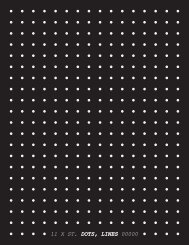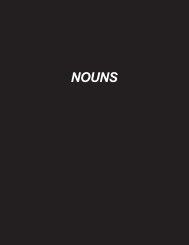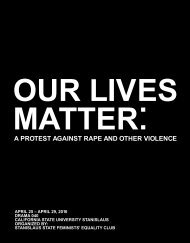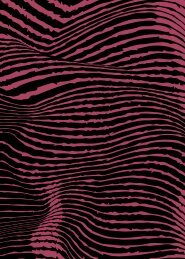The Unrepresentable: Art & Sexual Violence
You also want an ePaper? Increase the reach of your titles
YUMPU automatically turns print PDFs into web optimized ePapers that Google loves.
Vision in the <strong>Unrepresentable</strong><br />
By: Tinna Savini, MFA<br />
<strong>Unrepresentable</strong>: (Adj.) not capable of being represented.<br />
Origin: mid-17th century from un + representable<br />
(Oxford English dictionaries online)<br />
<strong>The</strong> <strong>Unrepresentable</strong>: <strong>Art</strong> and <strong>Sexual</strong> <strong>Violence</strong> is the second art exhibition, organized<br />
by the CSU Stanislaus Feminists’ Equality Club, in which students, faculty, and exhibitors<br />
once again joined their voices with many other campuses, institutions, organizations,<br />
survivors, and activists whose purpose is to raise awareness of the sexual violence too<br />
painfully frequent in global society. As the exhibition title suggests, most of the works shown<br />
in “<strong>Unrepresentable</strong>” attempt to picture those things we are not capable of representing or<br />
comprehending with respect to the inhumanity connected to sexual assault and violence. In<br />
the show we see visualized some of the solipsistic pathologies that can lead a person to so<br />
disengage and to violate the reality of another person as to cause her/him physical violence<br />
or psychological harm. Although the truth of such realities exists in life and in images, this<br />
exhibition also speaks of the resilience of individual voices and collectively of images that<br />
seed hope in the potentially cathartic effect of giving form to experience. In this way, these<br />
efforts are not mere reportage of the meanness too often felt in our culture; rather, they<br />
bring to consciousness a culture more humane and based on the realization of respect and<br />
kindness toward ourselves and all other beings with whom we share this planet.<br />
Many of the works visually reveal the intimate content of pain, fear, and suffering.<br />
Images of bruised faces and hands, absent gazes, uncomfortably close touches from hands<br />
not one’s own, blood, and exposed women’s bodies align with the broader theme addressing<br />
the issues of violence and sexual assault in our society. <strong>The</strong>se images show that violence,<br />
sexual assault, and the ignorance of societal attitudes that attend such aggressions leave the<br />
raw emotions of personal experiences unattended like free radicals waiting to congregate<br />
into a cancer. <strong>The</strong> eruption of negative emotions and the violence that often attends them<br />
are common enough that we need little explanation for some works. In one photograph by<br />
Brentt Wong, Love Note (2017), we see two small pictures of a beautiful young woman’s<br />
face set above a note with a few clearly legible handwritten sentences. We know that the<br />
scrap of paper with text commenting on her appearance has actually been a precursor to<br />
her assault. If we have any doubt, we need only look at the visual evidence of the large<br />
black-and-blue bruising that her eye shows us. We know that the pictures of her taken<br />
frontally and in profile are the kinds of views that are taken during a police report or clinical<br />
examination. We shake our heads with the familiarity of knowing for ourselves, or from<br />
someone close to us, that this is a custom so often passed down and too long tolerated. In<br />
another image by Hayley Simon, Medusa (2017), we see the closed composition of a nude<br />
female figure whose posture is contracted and whose head sinks between her two crossed<br />
2<br />
arms. Her long, wind-blown hair flies up like a Gorgon vision, but instead of a source of<br />
female power, all one can see is sorrow, much like the drawing of the same title by Van Gogh<br />
of his lover Sien Hoornik (1882), slumped in dejected form.<br />
Two works, which both address unwelcome touches, share content and polyptych<br />
form but do not use the same medium. In the first work by Natalie Wadlington entitled Two<br />
Acts (2016), two small, robustly-painted canvasses are juxtaposed, and each provides a<br />
view of Philip Guston-like thin, naked, prickly-haired teenage arms and legs whose genders<br />
appear to be that of a boy and a girl. <strong>The</strong> mingled body parts between the two images<br />
express the awkwardness of a pressured sexual advance. While in the quadriptych work<br />
by Christopher Benson, Affect/Effect (2017), the medium of the print serves to negate<br />
the intimate warmth of the painterly approach in the first picture, which heightens the<br />
awkwardness and anxiety one feels when looking at it. <strong>The</strong> repetition of the four pictures<br />
of the same image placed side by side shows a large hand and partial arm touching the<br />
asymmetrically-placed disembodied face of a beautiful young woman. <strong>The</strong> hand is not that<br />
of the woman; in fact, we see nothing of her body beyond her face. In each of the prints,<br />
her wide-open eyes are somewhat obscured by the clear glasses she wears. Yet the woman<br />
does not seem alive by having her own body or eye function but only by the connection<br />
of the hand to her face. Her realness is reduced to a fetishized memento, which is further<br />
enforced by the smaller images of other young women in collage formed all around her face.<br />
In the top pair, the word “GAZE” handwritten under one image and the word “BLEED” under<br />
the second image of the four images cause one to wonder if we are seeing through the eyes<br />
of a voyeur and/or perpetrator.<br />
<strong>The</strong> content of some works addresses the more general theme of “Take Back the<br />
Night,” the international event and nonprofit national organization whose mission it is<br />
to make the world a safe enough place for women to walk alone at night without fear of<br />
violence or molestation. In Kolaya Wilson’s Becoming Alive Again (2017), a watercolor image<br />
of a tiny headless female torso with arms in a prayer position is placed at the center of a<br />
larger circle in the middle of a rectangular format. <strong>The</strong> thin headless figure is not a horror,<br />
but rather reminds one of the headless fertility pendants of prehistoric times. <strong>The</strong> tiny torso<br />
image beckons us to envision our own heads atop the figure as it sits surrounded by the<br />
curvilinear vines that form a symmetrical tree design. Below this are two triangular shapes<br />
of green as fresh and verdant as the fresh growth of the seed-like center. Above in the upper<br />
third of the image, coming from both the left and right corners and stretching inward, are<br />
sturdy branches with lotus blossoms that compositionally conclude a diamond shape that<br />
focuses the eye once again on the center of the tendril tree and mythic mother torso. This<br />
is a memorable visualization that is like a vehicle we might use to realize a more kind and<br />
conscious culture, free of sexual assault and all that is unpresentable in sexual and other<br />
violence.<br />
3







